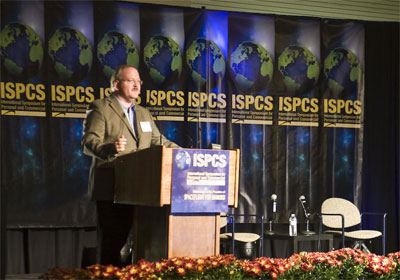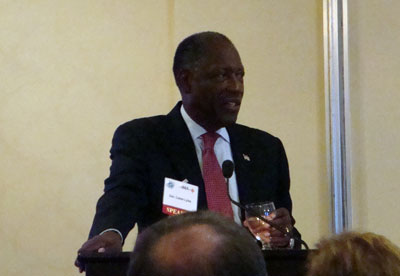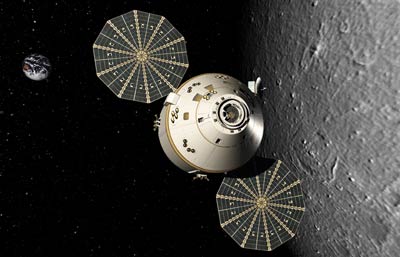And now we waitby Jeff Foust
|
| While the report’s release didn’t yield that “eureka moment of clarity”, it did generate a lot of shouting in the form of press releases and statements, primarily from members of Congress. |
Of course, Thursday afternoon’s release of the final report provided no such clarity. The report’s release and accompanying press conference in Washington was anticlimactic, in part because the final report built upon the options and findings the committee released in its summary report nearly a month and a half earlier. Moreover, it had become clear that while the release of the report was the end of the committee’s work, it signaled only the beginning of the policy deliberations within the White House, NASA, and Congress about which report option, if any, should be pursued (and, it can be argued, those discussions started weeks, if not months, before Thursday’s report.)
“I know we all had hoped that the release of the report would elicit a eureka moment of clarity, with a detailed roadmap with specific direction forward, but people, people,” joked Alan Ladwig, a NASA senior advisor, during remarks at the International Symposium for Personal and Commercial Spaceflight (ISPCS) in Las Cruces, New Mexico, shortly after the report came out Thursday.
Knee-jerk reactions
While the report’s release didn’t yield that “eureka moment of clarity”, it did generate a lot of shouting in the form of press releases and statements, primarily from members of Congress, often within hours or even minutes of the report’s release. In many cases the reaction paralleled the strong and rather negative reaction the committee got from Congress in September hearings after the release of the summary report (see “NASA’s next step: Augustine (and Obama) versus Congress”, The Space Review, September 21, 2009).
Some claimed to have found—or simply didn’t expect to find—little new in the summary report. “While I plan to review the Augustine panel’s final report, the Science and Technology Committee’s September 15th hearing to review the panel’s summary report has already provided me with important information on the state of the nation’s human space flight programs,” said Congressman Bart Gordon (D-TN), chairman of the House Science and Technology Committee. “At that hearing, Mr. Augustine reported his panel’s assessment that a meaningful exploration program can’t be carried out under the budgetary projections that accompanied the Fiscal Year 2010 NASA budget request—that more money will be needed if we are to do anything worth doing as a nation.”
Congresswoman Gabrielle Giffords (D-AZ), chair of that committee’s space subcommittee, effectively declared the report’s recommendations irrelevant. “While I look forward to reading the Augustine panel’s final report, Congress has already made its decisions on the issues considered by the panel,” she said in a joint statement with Gordon. “Now that both internal and external independent reviews have confirmed that the Constellation program is being well executed, we know what needs to be done. Let’s get on with it and cease contemplating our collective navels.”
| “While I look forward to reading the Augustine panel’s final report, Congress has already made its decisions on the issues considered by the panel,” Giffords said. “Let’s get on with it and cease contemplating our collective navels.” |
The need to increase NASA’s budget was cited by Republican and Democratic representatives alike from Florida’s Space Coast, ground zero for job losses once the shuttle is retired. “If the President is going to keep his promise to close the gap and keep America first in space he must revise his budget plan and put more money back into the NASA budget,” said Congressman Bill Posey (R-FL). “Without question, NASA needs additional funding to conduct meaningful space exploration that will have long-lasting scientific, technological and economic benefits,” said Congresswoman Suzanne Kosmas (D-FL).
Others, particularly members of Alabama’s Congressional delegation, were not pleased with the report. “The report released today by the Augustine Commission lacks the ambition and drive that first put our astronauts in space, beat the Russians to the moon, and is synonymous with the American space program,” said Congressman Parker Griffith (D-AL), whose district includes Huntsville, home to NASA’s Marshall Space Flight Center and the development of the Ares 1 rocket.
“We have spent 10 months studying this to only yield incomplete results at best,” Griffith continued in his statement. “The arguments that should have been made and the questions that should have been asked were ignored. These findings are incompatible with our national goals to return to the Moon, Mars and beyond, and we in Congress will not stand for it. We can do better.”
 Augustine committee member Jeff Greason argued that safety is more than what launch vehicle is safeest on paper. (credit: ISPCS) |
The safety dance
Griffith, in his comments, added that “the Constellation program has proven to be the best and safest option to continue America’s legacy as the leader in manned spaceflight,” something he believed the Augustine committee ignored. A House colleague, Congressman Robert Aderholt (R-AL), added that he thought that the report lacked “safety data that would help the White House or leaders in Congress to guide the future of NASA.”
Even before the report came out, a powerful Senate Republican fired a preemptive shot against the report, again focused on the issue of safety. In a speech on the Senate floor Wednesday, Richard Shelby (R-AL) took on the Augustine report and what he perceived to be a lack of emphasis on safety.
The Chairman of the Review of U.S. Human Space Flight Plans Committee, Norm Augustine, announced that safety would be paramount. Yet, from reviewing the preliminary information, there is only one area where mission safety was examined in the report. The Augustine report contained no safety comparison for the various vehicles considered by the panel and no risk assessment based on each option. The only safety issue identified was an assessment of how “hard” the panel thought each overall mission would be to achieve--not the safest means to complete the mission successfully. Since safety is the most important issue, these omissions are starling to some of us.
When making comparisons on the safety and performance of the various options, fundamental design differences cannot be lumped together and considered to be equal. Without an honest and thorough examination of the safety and reliability aspects of the various designs and options, the findings of this report are worthless. I would like to know why this blue ribbon panel did not examine these safety aspects.
Constellation’s vehicles have been planned and scrutinized by multiple stakeholders, all with a single goal in mind: to provide a safe and reliable human space flight system for our Nation.
| “Launch is a relatively small contributor to the safety and mission assurance” of human missions to the Moon and beyond, said Greason. “It is not negligible, it is not something you want to forget about, but it does not dominate the loss of crew probabilities.” |
The same day that Shelby spoke, one of the members of the Augustine committee, Jeff Greason, talked about his work on the committee at the ISPCS. His comments were similar to those he gave three weeks earlier at a conference in Boston (see “A committee member speaks”, The Space Review, October 5, 2009) but did bring up the question of safety in a manner than served as a counterpoint to Shelby.
In the Q&A session after his speech, he was asked why the committee didn’t endorse Constellation as the “most viable” option “even though from a safety and mission assurance standpoint it’s clearly the best option.” Greason said that safety and mission assurance was considered by the Augustine committee, but that goes beyond simply the choice of launch vehicles.
“Launch is a relatively small contributor to the safety and mission assurance” of human missions to the Moon and beyond. “It is not negligible, it is not something you want to forget about, but it does not dominate the loss of crew probabilities.” Therefore, he said, it was a mistake to focus on further increasing the reliability of a relatively small aspect of overall mission risk, particularly if those choices lead one to take out safety systems in other components that because of mass restrictions. “These are false economies in terms of safety and mission assurance.”
Greason was also skeptical about the probabilistic risk assessments used to estimate the safety of various proposed systems. Most launch failures are not from random types of events, he said, but instead failures of design, testing, procedure, and the like. “If it was built wrong, it doesn’t work a lot of the time, no matter what you thought the probabilistic failure was.” The only way to “buy down” those failures, he said, is though flight experience, which is why “real boosters” have lower reliabilities than estimated when they were “paper boosters” still in the design phase.
“And the truth is, Ares 1 is, right now, a paper booster,” Greason continued. “And the further truth is, its projected launch rate is extremely low, so it will never get out of ‘infant mortality,’” that initial phase of non-probabilistic failures. “Even if Ares 1 were built exactly as planned, we would never find out whether its mature probabilistic risk assessment was or was not achievable as planned, because we would never get through the phase of life where we’re supposed to work out all the teething problems.”
 Lester Lyles, who also served on the Augustine committee, endorsed the current “program of record” in a speech. (credit: J. Foust) |
Unanimous options, differing opinions
At the Thursday afternoon press conference, committee chairman Norm Augustine reiterated that the purpose of the committee was not to make recommendations on the direction the nation should pursue, but instead provide options and leave it up to policymakers to choose a particular path. “All the findings in the report are strictly those of the members of the committee,” he said. “I am happy to say that everything that is in the report has the unanimous support of the committee members.”
While the report’s contents might be unanimously endorsed by the ten-member committee, its members have expressed differing opinions on which option they would pursue, particularly when it comes to specific launch architectures. “This one of the areas where there was essentially no consensus” among the committee members, Greason said at the ISPCS.
Retired Air Force Gen. Lester Lyles, for example, expressed a preference for the “program of record”—the committee’s term for the existing Constellation architecture—during a luncheon speech Tuesday in Washington organized by the Washington Space Business Roundtable and Women in Aerospace.
“The current program of record, in my opinion, seems to be the right one,” he said in his remarks. Later, in the Q&A session, he reiterated his stance. “I’m a big, big believer in the need for rocket technology, so I personally want to see Ares 1 going, and see the program going as it’s currently structured,” he said. “Now, we may look at some other options, and that might be the right thing to do—probably is, always, just to play it safe—but I certainly would not want to disrupt” the current program, which he called “very, very successful”.
Lyles also said that the Air Force has concerns about human-rating EELV launchers, one of the other options included in the report, “not from a technical standpoint, but a program interruption standpoint for the national security space activities.”
| “To put it brutally,” Greason concluded, “this trade, to my mind, is a trade between whether we have a space program or a jobs program.” |
Gary Payton, the deputy undersecretary of the Air Force for space, also said he had concerns about architectures that required human-rating the EELV. “It would end up fundamentally meaning an EELV for human launch and an EELV for everybody else,” he said in response to a question at the ISPCS on Wednesday. “That tends to make both of those designs more expensive.” The additional launches of human-rated EELVs might drive down costs of some components because more of them will be needed, he said, but that could be negated by increased design costs to create a human-rated version.
However, Greason was not enamored with Constellation. The Ares 1/Ares 5 architecture, he said in his ISPCS speech, “traded less favorably across almost all figures of merit than any of the other options.” Among other issues, he said, the flight rates of both boosters are so low that the program would be dominated by high fixed costs.
Greason, after going through the various merits of the Ares 5 Lite and other shuttle-derived alternatives, leaned towards the EELV-derived option. “The EELV option shares the overhead of keeping the boosters going with other customers,” namely, the Air Force and commercial customers, reducing NASA’s fixed costs. It would not, though, enable reuse of shuttle infrastructure, or the thousands of people currently employed by it, something that Greason admitted made it a “hot-button” option among some.
“To put it brutally,” Greason concluded, “this trade, to my mind, is a trade between whether we have a space program or a jobs program.”
The need for patience
With the report now complete, the question now on everyone’s minds is when the White House will make a decision on which option it will pursue, and also how much additional funding for NASA it will seek from Congress. That process is already underway: at Thursday’s press conference Augustine said the committee provided its summary report, and a briefing, to the White House at the end of August. “They had the data they needed, I think, to put the budget together,” he said. “They’ve been deliberating there, and, in terms of where they go from here forward, I’m frankly not in a position to know.”
NASA’s Ladwig said he couldn’t speculate on what path the administration would select. “It remains premature for anyone at NASA to draw conclusions or speculate about future spaceflight plans or policies based on the committee’s final report,” he said in his ISPCS remarks. He did expect that the White house would call upon a number of agencies, including the Office of Science and Technology Policy, Office of Management and Budget, and the National Security Council, to turn the report’s options into a new policy.
| “So while it is likely that we’ll hear something about our fate from the president before the end of the year,” Ladwig suggested, “a complete view of the new-and-improved NASA may not be completely defined until the release of the 2011 budget.” |
He added he hoped Congress would also be involved, to avoid repeating the mistake made 20 years ago when the Space Exploration Initiative was crafted without Congressional input, and died in Congress shortly thereafter. He added that he would no be surprised if President Obama himself got involved in the deliberations at some point before the plans were finalized. “He likes to get involved in these discussions sooner than later, so I don’t envision that he’ll be sitting by and won’t see anything about this until the very last moment.”
As for when, Ladwig said he hoped the decision would be made soon enough to influence spending plans for fiscal year 2010 and the planning process for the fiscal year 2011 budget. That latter milestone might mean a longer wait, since details of the budget proposal are shrouded in secrecy until the budget is released in early February. “So while it is likely that we’ll hear something about our fate from the president before the end of the year,” he suggested, “a complete view of the new-and-improved NASA may not be completely defined until the release of the 2011 budget.”
And that, of course, won’t be the end of the process. While the president proposes, as the saying goes, Congress disposes, and appropriators and authorizers alike will weigh in on any new plan, especially one that represents a shift from the status quo. So those seeking that “eureka moment of clarity” about NASA’s future may have a long wait in store for them.
